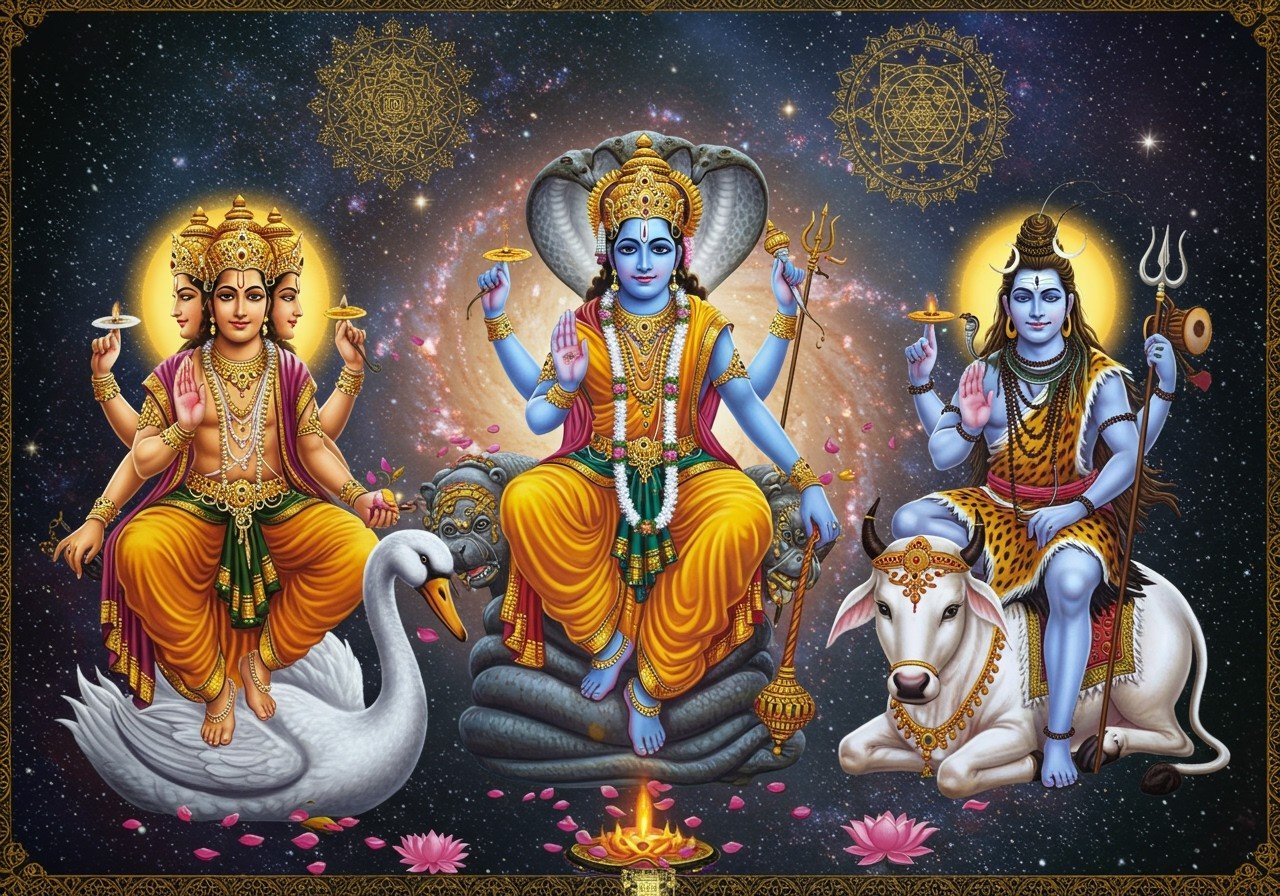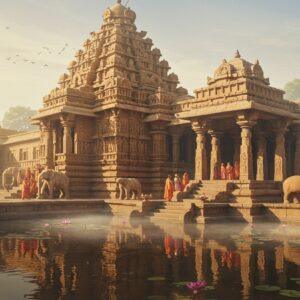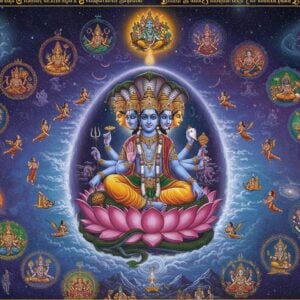
The Trimurti, or Hindu Trinity, is central to Hindu beliefs, representing the three gods: Brahma, Vishnu, and Shiva. This concept illustrates the cycle of the universe through creation, preservation, and destruction. Understanding Trimurti art and symbols can deepen one’s appreciation of Hindu traditions and spirituality.
Historical Background of the Trimurti
The Trimurti’s origins trace back to ancient Hindu scriptures, including the Puranas and Upanishads. These texts introduce Brahma as the creator, Vishnu as the preserver, and Shiva as the destroyer. The Trimurti concept emphasizes the universe’s cyclical nature, influencing various Hindu sects like Vaishnavism and Shaivism.
- Brahma: Known as the creator of the universe, often depicted with four faces, each reciting a Veda. He is associated with knowledge, wisdom, and creation, and his vehicle is a goose or swan.
- Vishnu: The preserver and protector, Vishnu descends to earth in various avatars to maintain cosmic balance. He is often portrayed with blue skin and holds symbolic objects like a conch, discus, mace, and lotus.
- Shiva: As the destroyer and transformer, Shiva brings about change and regeneration. Recognizable by his third eye, trident, and serpent, he is often depicted as an ascetic with matted hair. His vehicle is Nandi, the bull.
Each deity’s distinct roles and attributes underscore their significance within Hindu philosophy. The Trimurti reflects the universe’s continuous cycle of creation, preservation, and transformation.
Artistic Depictions of the Trimurti
The Trimurti holds a prominent place in India’s artistic heritage, embodying spiritual beliefs. Across various regions and periods, artists have portrayed the Hindu Trinity in diverse forms. The magnificent Trimurti sculpture at the Elephanta Caves, a UNESCO World Heritage Site, captivates with intricate details that narrate divine power.
From temple architecture to paintings and manuscripts, artistic expressions reflect the Trimurti’s theological messages. Each deity’s representation carries symbolic elements. For instance, multiple arms and heads emphasize omnipotence. Regional styles vary, from the bronzes of South India to the stone carvings of North India, each possessing unique artistic characteristics.
Explore the many forms of Lord Ganesha.
Symbolism in Trimurti Art
Trimurti art is rich in symbolism. Brahma’s four faces represent the four Vedas, while his multiple arms symbolize his creative power. Vishnu’s conch, discus, mace, and lotus signify his role as the sustainer and protector. Shiva’s trident represents his destructive power, his third eye symbolizes wisdom and insight, and the snake around his neck represents cyclical time. These symbols offer deeper meaning, reflecting cosmic balance and the interconnectedness of existence. Each deity embodies a crucial aspect of life, inviting reflection on life’s cycles and the harmony within the universe. You can further explore related concepts, like the significance of Aarti, on Poojn.in. Unveiling the Profound Significance of Aarti.
How to Draw the Trimurti
Creating your own Trimurti drawing can be a fulfilling artistic endeavor. Begin by sketching a basic framework for each deity, focusing on proportion and alignment. Strive to capture Brahma, Vishnu, and Shiva’s unique expressions. Carefully incorporate symbolic elements like multiple arms, paying close attention to detail for authenticity. Using traditional materials such as charcoal or watercolor can add depth to your artwork. Embrace this artistic journey as a means of connecting with spirituality.
Modern Interpretations and Adaptations
In contemporary times, artists continue to reinterpret the Trimurti in innovative ways. Digital media blends tradition with modern technology, while art installations offer fresh perspectives on these ancient themes. The Trimurti’s presence extends to films and literature, conveying universal messages. In our increasingly interconnected world, these adaptations promote cultural heritage and spiritual awareness, ensuring the timeless wisdom of the Trimurti continues to inspire and resonate with audiences.
How Poojn.in Helps You Honor the Trimurti
Poojn.in provides authentic products that facilitate a deeper connection with the divine Trimurti. Our curated selection includes:
- Trimurti Idols: Finely crafted brass and marble statues depicting Brahma, Vishnu, and Shiva together. Ideal for home temples or meditation spaces. Explore our exquisite collection of Trimurti idols.
- Individual Deity Statues: Separate idols of each Trimurti deity, meticulously crafted by skilled artisans adhering to traditional iconography. Find individual deity statues here.
- Puja Essentials: Comprehensive sets of items required for Trimurti worship, including brass diyas, pure cotton wicks, premium incense sticks, copper or brass water vessels, and traditional bells (ghanti). Enhance your worship with our high-quality puja essentials. Browse our Puja Essentials collection.
- Sacred Texts: Printed editions of significant scriptures that elaborate on the roles and significance of the Trimurti. Deepen your understanding with our selection of sacred texts. Explore the meanings and significance of Krishna’s names.
All Poojn.in products are securely packaged to ensure safe delivery throughout India. Our dedicated customer service team is available to assist you in selecting the most appropriate items for your spiritual practices. We meticulously verify the authenticity and quality of all products before listing them on our platform.
Visit www.poojn.in to explore our comprehensive collection of Trimurti-related items and other puja essentials. We offer secure online payment options and deliver to most locations within India.
[Note: Product availability and prices are subject to change. Please refer to our website for the most up-to-date information.]
Celebrating the Trimurti in Everyday Life
The Trimurti continues to inspire and enrich lives worldwide. Its presence in art and iconography reminds us of the deep connection between the divine and human creativity. By appreciating these depictions, we honor the enduring wisdom and spiritual depth they represent. From traditional sculptures to contemporary adaptations, the Trimurti invites us to explore the balance of creation, preservation, and transformation. Embracing these representations in our homes and communities helps preserve a treasured cultural heritage that resonates with our shared human experience.
FAQs on The Trimurti
What is the Trimurti in Hinduism? The Trimurti represents the three principal deities: Brahma, the creator; Vishnu, the preserver; and Shiva, the destroyer.
What is the significance of Trimurti images? Trimurti images symbolize the continuous cycle of creation, preservation, and destruction, highlighting the balance inherent in the universe.
How is the Trimurti depicted in art? The Trimurti can be portrayed as three faces on a single form, each representing Brahma, Vishnu, and Shiva. Alternatively, they may appear as separate figures within a unified artwork.
What materials are used to create Trimurti sculptures? Trimurti sculptures are crafted from various materials, including stone, metal, wood, and clay, each chosen for its durability and suitability for carving.
How can I draw the Trimurti? To draw the Trimurti, start with a basic sketch of three faces, each with distinctive features representing Brahma, Vishnu, and Shiva. Incorporate symbolic elements like Brahma’s beard, Vishnu’s conch, and Shiva’s trident.
What symbolism underlies the Trimurti in iconography? The Trimurti’s iconography reflects the unity and diversity of the divine, demonstrating the interconnectedness of life’s different facets.
Why do people worship the Trimurti? Worshipping the Trimurti is believed to bring balance and harmony into one’s life by honoring the fundamental cycle of creation, preservation, and transformation.


